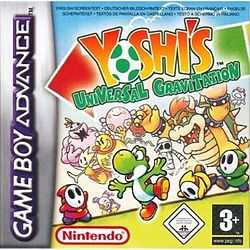Yoshi's Universal Gravitation
| Yoshi's Universal Gravitation Yoshi Topsy-Turvy | |
|---|---|
 European box art | |
| Developer(s) | Nintendo, Artoon |
| Publisher(s) | Nintendo |
| Director(s) | Hidetoshi Takeshita Hiroto Saiki |
| Producer(s) | Masaki Tawara Naoto Oshima |
| Artist(s) | Yasuhisa Nakagawa |
| Composer(s) | Tatsuyuki Maeda Masaru Setsumaru Mariko Nanba |
| Platform(s) | Game Boy Advance |
| Release date(s) |
|
| Genre(s) | Platforming |
| Mode(s) | Single-player |
Yoshi's Universal Gravitation (ヨッシーの万有引力 Yosshī no Ban'yū Inryoku), also known as Yoshi Topsy-Turvy in North America, is a platform game for the Game Boy Advance that was developed by Artoon and published by Nintendo. It features a built-in tilt sensor, which is used to manipulate the game's environment. By tilting the Game Boy Advance left or right, the player can tilt the game area, causing enemies and other objects to slide as the direction of gravity changes. This gameplay mechanic is used to solve puzzles or aid Yoshi in completing levels. Due to the tilt-sensing device that is required for gameplay, this game is one of the few Game Boy Advance titles that is not compatible with the Game Boy Player for the Nintendo GameCube.
Plot
The plot and graphics are similar to those of Yoshi's Story for the N64.
When Bowser starts wreaking havoc on Yoshi's Island, a book spirit named Hongo traps the entire island within the pages of a storybook. Only by locking Bowser away Yoshi can convince Hongo to release the rest of the island, so he sets out to progress through the chapters of the book.
Each course is controlled by a spirit, each with an obsession — one loves money, one loves fast things, one loves friendliness, one loves strength, etc. They will set out guidelines for the course, such as collecting fruit to free a certain number of Egglings, finishing a course before time runs out, finding a certain number of coins or defeating — or not defeating — a certain number of enemies. By satisfying that spirit's requirements, players pass the course.
Yoshi can jump and stick out his tongue to eat fruit or enemies, but the main feature of the game is the tilt mechanism. By moving the Game Boy Advance side to side, players tilt the world around Yoshi, causing enemies to roll around, swinging ships and pendulums, and bouncing items all over the place. An impassable wall will become a climbable slope, or a rolled-up carpet will become a long platform. Each environment requires players to master not only button presses but also tilt movements to progress.
Gameplay
By tilting the Game Boy Advance, the environment around Yoshi is rotated to knock over enemies, swing pendulums, and to help Yoshi run up walls and leap huge pits. All of Yoshi’s Island is trapped in a storybook, and only by meeting certain chapter-specific challenges can a chapter be completed.
Reception
| Reception | ||||||||||||||||||||||||||||||||||||||||||||||||||||||||||||||||||||||||||||
|---|---|---|---|---|---|---|---|---|---|---|---|---|---|---|---|---|---|---|---|---|---|---|---|---|---|---|---|---|---|---|---|---|---|---|---|---|---|---|---|---|---|---|---|---|---|---|---|---|---|---|---|---|---|---|---|---|---|---|---|---|---|---|---|---|---|---|---|---|---|---|---|---|---|---|---|---|
| ||||||||||||||||||||||||||||||||||||||||||||||||||||||||||||||||||||||||||||
At the time of its release, most critics thought of Yoshi's Universal Gravitation as a mediocre title. Craig Harris of IGN said the game was too short, and most critics thought the other Game Boy Advance game to use a tilt sensor, WarioWare: Twisted!, was a better example of tilt-sensing technology in video games. 1UP.com's Jeremy Parish called the tilt controls "graceless and clumsy" and the character animations "choppy", concluding that it was a "mediocre" and "boring" game. GameSpot's Justin Calvert thought the tilting worked alright and enjoyed the graphics and difficulty curve, but overall found the game to be "repetitive and disappointingly short". Game Informer enjoyed the tilt sensing, calling it a "neat" and "inventive" mechanic that "breathe[d] new life into the [platformer] genre", but was disappointed by the level designs, which were mostly "pretty standard fare."[6][3][5][4]
Another point that is often criticized is that, due to the tilt-sensor and its orientation, the game can only be comfortably played on the original Game Boy Advance, while it is confusingly mirrored on the Game Boy Advance SP and not playable at all on the Game Boy Player. However, the game includes a menu screen at startup in which the player can select the handeld system they are using: either the original Game Boy Advance, in which the cartridge gets inserted in the top of the system, or the Game Boy Advance SP, Game Boy Micro or Nintendo DS which features a bottom loading slot to insert the cartridge. This eliminates mirrored tilt sensing so the game can be played on any of those handheld devices.[8] The player can also re-calibrate the tilt sensor to fit whichever game system they use.
|
References
- ↑ "Yoshi Topsy-Turvy". GameRankings. CBS Interactive. Retrieved September 2, 2013.
- ↑ "Yoshi Topsy-Turvy Critic Reviews". Metacritic. CBS Interactive. Retrieved September 2, 2013.
- ↑ 3.0 3.1 Parish, Jeremy (June 10, 2005). "Not Much Fun Any Way You Look at It". 1UP.com. IGN Entertainment. Retrieved September 2, 2013.
- ↑ 4.0 4.1 Matt (August 2005), "Twisting the Night Away", Game Informer (GameStop): 108, archived from the original on November 18, 2005
- ↑ 5.0 5.1 Calvert, Justin (June 10, 2005). "Yoshi Topsy-Turvy Review". GameSpot. CBS Interactive. Retrieved September 2, 2013.
- ↑ 6.0 6.1 Harris, Craig (June 10, 2005). "Yoshi Topsy Turvy". IGN. IGN Entertainment. Retrieved September 2, 2013.
- ↑ Nintendo Power, August 2005: 84
- ↑ http://www.purpleyoshispage.com/yttmanual.shtml
External links
| |||||||||||||
